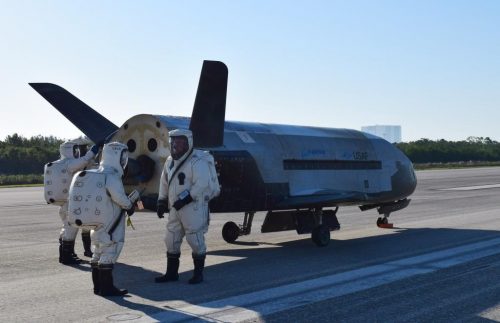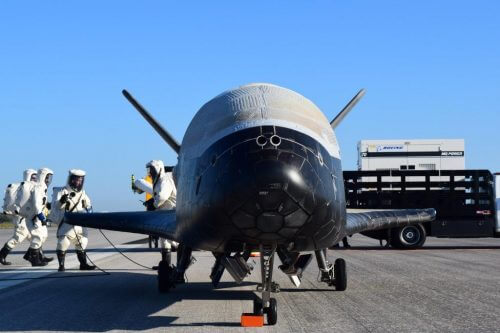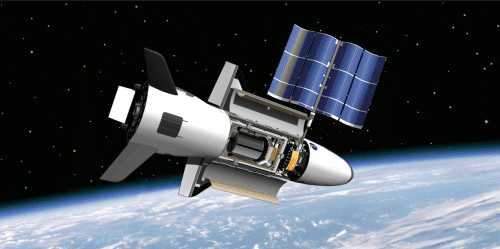The robotic space plane of the US Air Force, X-37B, landed yesterday at the Kennedy Space Center in Florida, after spending 718 days on a secret mission in space.

The X-37B space plane, an unmanned and small version of the space shuttles, returned to Israel yesterday after a secret US Air Force mission that lasted 718 days. The plane began its mission on May 20, 2015, with its launch into space on the Atlas 5 launcher.
For the first time, the plane landed on the runway SLF The historic one at the Kennedy Space Center in Florida, which was used by the space shuttles until their retirement in 2011. In its previous missions, the vehicle landed at Vandenberg Air Force Base in California.
This is the fourth mission of the space plane. Similar to its previous missions, the vehicle once again broke its own record for staying in space: its third mission lasted 674 days (between 2012 and 2014), its predecessor lasted 468 days (2011 – 2012) and the first mission lasted 224 days (2010). Although according to the US Air Force its nominal stay in space is 270 days, these missions show that the vehicle is capable of much more than that.
The American Air Force said that the vehicle will be launched this year for another mission.
mini-space shuttle
The vehicle is very similar to the space shuttles, but much smaller than them: its length is 8.9 meters, its height is 2.9 meters and its wingspan is 4.5 meters. The space shuttles, on the other hand, were 37 meters long, and their wingspan was 24 meters. In fact, the small vehicle originally designed to be suitable for launch inside the luggage compartment of the shuttles, but the idea was eventually abandoned in favor of launching on a regular rocket (what is more, the space shuttles have not been active for a long time).
Like the shuttles, the X-37B is also multi-purpose. It is launched into space on the nose of a launch vehicle like any other satellite (Atlas 5 In his case), but able to penetrate the atmosphere and land on Earth like a glider. Unlike the shuttles, which were controlled by space pilots, the vehicle operates completely automatically.

The X-37B has solar panels that deploy in space from its cargo hold, greatly extending its possible stay in orbit. This is in contrast to the space shuttles, which used hydrogen fuel cells to generate electricity, and were therefore limited in the duration of their missions (the longest mission of a space shuttle lasted 17 days, and is STS-80 of the Columbia shuttle conducted in 1996).
The development of the vehicle began by NASA in 1999, and in 2004 the development was transferred to the DARPA agency of the US Department of Defense. Two years later, the US Air Force announced that it would develop the X-37B space vehicle based on these plans, and Boeing built two identical versions of the vehicle for it, each of which performed two of its four missions.
What did the vehicle do so long in space?
The vehicle's exact missions are shrouded in heavy secrecy. The American Air Force denied reports that the vehicle is used as a space weapon (for example - to destroy foreign satellites). According to the Corps, the vehicle is used as a platform to examine technologies related to satellites and space vehicles, such as automatic navigation and control systems, as well as to perform experiments in space conditions and return them to Israel for testing.
An important detail concerning the nature of its mission is its orbital path. The US Air Force has never released the details of the X-37B's orbit, but amateur astronomers have been able to observe it and determine whose orbit ranges between 280 km and 400 km (the altitude at which the International Space Station is located). On the first mission of the space plane in 2010, The New York Times reported Because observers noticed that the vehicle passed over the same point on the ground every four days - a trajectory similar to that of spy satellites.

In its last mission, two of the experiments carried by the vehicle were revealed for the first time. One of them was an experiment to test a type of electric ion engine Hall thruster, which will be used by military communication satellites in performing orbital maneuvers. Ion engines use ionized gas that is accelerated to a very high speed and creates thrust. These engines are more efficient than traditional chemical engines, and while their thrust is lower, they are able to operate continuously and for a long time.
Another mission that was launched on top of the vehicle was NASA's, andin the context of About 100 samples of various materials were exposed to space. Now that the vehicle has returned to Israel, the materials will be tested to see how they were affected by the prolonged stay in space conditions.
See more on the subject on the science website:
- The US Air Force's mysterious space plane has broken its previous record for staying in space
- The US military space plane X-37B took off for the fourth mysterious mission. It was also accompanied by an experimental solar sail during the launch
- The mysterious X-37B military space plane has landed after two years in orbit
- The unmanned X-37B spacecraft returned from space after 220 days
Watch a vehicle land at the Kennedy Space Center in Florida:
https://www.youtube.com/watch?v=5wBjpZh6faY

8 תגובות
falcon
NASA did not invest a penny in this pen. Fisher invested the money - that's what it says in the article you linked to 🙂
I have had a pen like this for many, many years, and it really is an excellent pen. A million dollars for development is small money...
Husham, read this before you post nonsense
https://www.scientificamerican.com/article/fact-or-fiction-nasa-spen/
NASA invested 1 million dollars in the development of the pen and the Soviets started to purchase it after it was developed.. until then they both used regular mechanical pencils.
Why are there details of a secret spaceship?
If the mission is secret, how were its details published?
You don't change a horse from a slaughter
When NASA started sending astronauts into space, they quickly discovered that ballpoint pens would not work in zero gravity. To deal with the phenomenon, NASA spent a decade and spent about 12 billion dollars to develop a pen, which works in zero gravity, upside down, under water, and in almost any surface conditions, including glass and at temperatures ranging from below zero degrees Celsius to 300 degrees. The Russians used a pencil…
I think the parachute method is only good for low weights, not for weights like this shuttle with all the gear inside.
I don't understand why it's worth investing so much in a space vehicle resembling an aerodynamic plane... whose structure and landing are so complicated and dangerous when you can achieve the exact same thing by landing a spacecraft/capsule using parachutes like the Russians do.